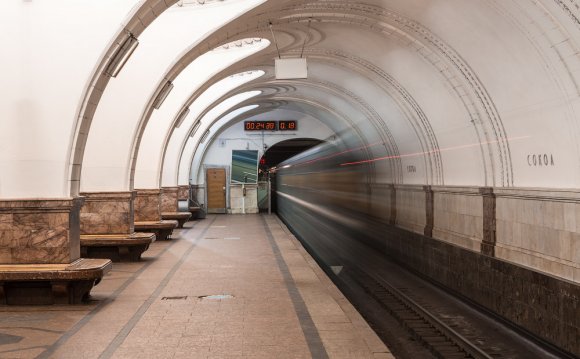
 1935♪ The first line of the metropolitan line, from the Socolnikov to the " Cultural Park " , with the response to the " Small " , is composed of intergenerational architects working in a variety of styles, from the rationalist Nikolai Ladovsky (Dzerzinski, Rad Gate) to the proletarian classics of Ivana Fomín ( "
1935♪ The first line of the metropolitan line, from the Socolnikov to the " Cultural Park " , with the response to the " Small " , is composed of intergenerational architects working in a variety of styles, from the rationalist Nikolai Ladovsky (Dzerzinski, Rad Gate) to the proletarian classics of Ivana Fomín ( "

1938♪ The second line of the Moscow Metro is open, the Gorkovsky radius from Theater to Sokola. It is a meeting of some of the most elegant stations of the Moscow Metro: Sokoll, whose columns are transformed into a dome, Aeroport, which is cut by thin relay strips, Dinamo, where the walls of the pilons are made out of the hinted inner apples, and of course one of the most signs. Moscow subway - Filled with light and air by the Mayakovsky architect Alexei Drushkin.

1943-1944. Despite the war, the construction of the metropolitan continues, 7 new stations have been opened. The architectural projects developed prior to 1941 have been supplemented by artistic designs related to the Great National War. Thus, these stations become one of the first monuments of the forthcoming victory.
1950-1954. The apopheos of the steel style is the construction of the Ring Line and the new track of the Arbat radius. Despite the diversity in the processing of stations, the Thagan Gothic motives, the ancient-Russian Dobrinian, the barracks of Arbat, all of them unite the limit (and sometimes limit) solemnity and decorativeness. The main theme of station design is victory in the Great National War.
Despite the diversity in the processing of stations, the Thagan Gothic motives, the ancient-Russian Dobrinian, the barracks of Arbat, all of them unite the limit (and sometimes limit) solemnity and decorativeness. The main theme of station design is victory in the Great National War.
1957. The resolution " Removals in design and construction " (1954) results in the revision of projects: construction stations are being simplified (GNH, Sports, etc.), in 1958 the first earth stations (Studence, Kutuzovskaya), which are more cost-effective, the first model station called " Porvomay " , with three probes. The term " sorrowing " with the travel walls marked by the ceramic plug, columns marked by a certain marble class and rib ceiling has become dominant in the Moscow subway architecture for many years.












